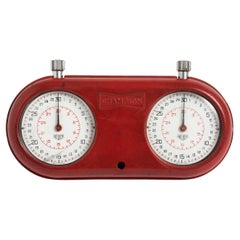Heuer Champion Stopwatches
Recent Sales
Vintage 1970s Pocket Watches
Heuer for sale on 1stDibs
Esteemed brand TAG Heuer embodies the rich and innovative spirit of Swiss watchmaking and has played a prominent role in the long history between motorsports and luxury watches.
TAG Heuer’s beginnings were humble. The company was initially called Heuer Watchmaking Inc. and originated in the small town of St-Imier in Switzerland, where Edouard Heuer began making silver pocket watches on his family farm in 1860. Heuer registered his first patent as Edouard Heuer & Compagnie in 1869 for the oscillating pinion, a keyless winding mechanism that revolutionized the chronograph and became the standard for all modern watches.
Heuer’s interest in sports led to further innovations in watchmaking, as the company produced pocket chronographs for the crowds that gathered at horse races and greyhound races during the 1880s. The watchmaker made timepieces for the medical profession and precision chronographs for the dashboards of airplanes and motor vehicles in the years that followed. It supplied stopwatches to the Olympics during the early 20th century, not long after Edouard’s son, Charles-Auguste Heuer was installed as head of the company. Its chronograph technology eventually migrated to wrists.
Motor racing and luxury watches have long been intertwined — Rolex, for example, was named the official timekeeper of the Daytona International Speedway in 1962, and its Daytona would appear soon afterward. Heuer’s lofty position in the sport was cemented by then — racers widely preferred Heuer chronographs, and the first iteration of the popular Heuer Autavia was a dashboard timer. The brand’s recognition continued to grow in the 1960s — the first Swiss timepiece to travel into space was the Heuer strapped to astronaut John Glenn during his historic 1962 orbit around the Earth, and the company’s association with Formula 1 also took shape during the decade.
In 1969 — the year that Heuer, Breitling and Hamilton collectively debuted their revolutionary automatic chronographs at Basel Watch Fair — Porsche driver Jo Siffert became Heuer’s official brand ambassador — the first personal sponsorship in F1 history that was non-automotive.
The Heuer Autavia chronograph reference 1163T, also known as the “Siffert” in Formula 1 circles, reached legendary status among racing fans, along with the Monaco and Heuer Carrera chronographs. The latter was designed by Edouard’s great-grandson Jack Heuer, while the now-internationally renowned square-shaped Monaco earned the spotlight when Steve McQueen wore one in the 1970s movie Le Mans. The model was later lovingly dubbed the “McQueen Monaco.”
TAG is an acronym for "Techniques d'Avant Garde" — it comes from the name of the TAG Group, a private holding company based in Luxembourg that acquired the watchmaker in 1985. TAG Heuer continues to produce high-quality luxury watches that use innovative materials, such as titanium, carbon fiber and lab-grown diamonds, underlining the brand’s commitment to sustainability. After four generations of Heuer family leadership, the company now operates under LVMH.
TAG Heuer continues to embrace the new, offering a range of smartwatches, such as its Connected model, that merge traditional craftsmanship with modern features like fitness tracking and smartphone notifications. In 2023, the TAG Heuer Carrera was named the “hottest watch” of the year by GQ magazine.
Find Heuer wristwatches on 1stDibs.
Finding the Right Pocket-watches for You
Can you pull off a vintage pocket watch? Of course you can. With a suit and a waistcoat, a pocket watch can be a refreshing alternative to a wristwatch.
The earliest pocket watches were luxury items, and, owing to cost, they weren’t commonplace until the 19th century. Artfully crafted pocket watches were a symbol of wealth, and manufacturers such as Vacheron Constantin and Patek Philippe became known for theirs. (Today, they’re among the most sought after by collectors and enthusiasts.)
At the onset, pocket watches resembled small round table clocks, and pulling your small round table clock — perhaps of the silver variety — out of your breast pocket in front of someone else demonstrated unequivocally that you cared about punctuality. For collectors, pocket watches are big, and that means a larger canvas provided for functions without crowding the dial. For example, the Marius Lecoultre pocket watch — made circa 1890 — does everything but uncork your wine.
In the late 1800s, the open-face pocket watch became a staple on the American railroad. It was a requirement for railway workers to wear a pocket watch, as the timepieces were responsible for keeping conductors on schedule. This was a boon to the watchmaking industry, with companies like Hamilton, the Elgin National Watch Company and the Waltham Watch Company producing high-grade and workingman’s watches.
By the 1930s, wristwatches comprised the bulk of watch manufacturing in America, superseding the pocket watch. Suddenly, if you wanted to know the time, you merely glanced at your wrist. But given their vintage charm and our general appetite for good design, pocket watches are a piece of statement-making jewelry and today can prove complementary to your formal attire in a manner that is stylish and unconventional.
Let time take its course — browse a vast selection of antique and vintage pocket watches available on 1stDibs designed by legendary brands such as IWC, Cartier and more.
